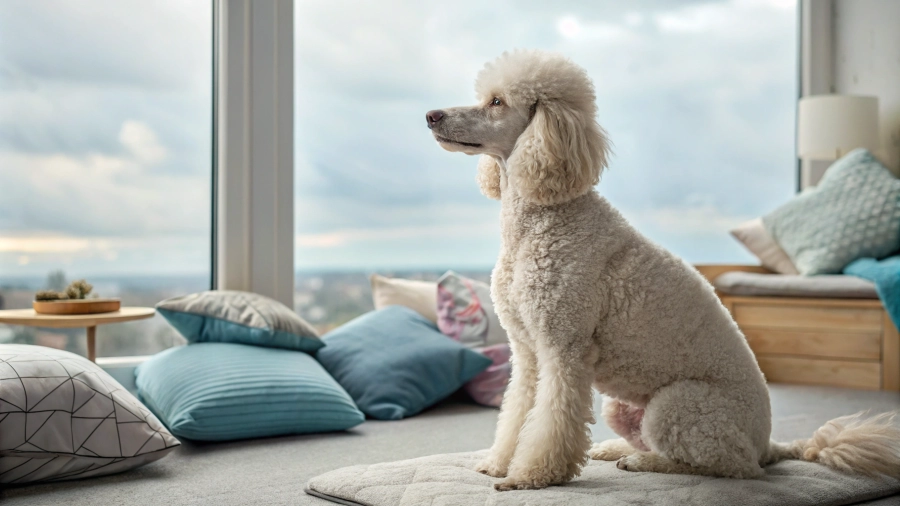To get your poodle to stop whining, you need to understand why it’s happening. A poodle may whine due to anxiety, boredom, or seeking attention.
Poodles are known for their intelligence and sensitivity. This makes them prone to whining when their needs aren’t met. Whining can be frustrating, but with patience and the right approach, you can help your poodle calm down. In this guide, we will explore effective strategies to address the root causes of whining.
You’ll learn how to create a peaceful environment and establish a routine that keeps your poodle happy and quiet. By understanding your poodle’s behavior, you can foster a stronger bond and enjoy a more peaceful home.
Identifying The Cause
Understanding why your poodle is whining is crucial to addressing the behavior. Dogs whine for various reasons, and identifying the cause can help you find the right solution. In this section, we’ll explore common triggers and behavioral patterns that may cause your poodle to whine.
Common Triggers
Several factors can trigger whining in poodles. Here are some common ones:
- Attention-seeking: Poodles may whine to get your attention. This can happen if they feel ignored or want to play.
- Hunger: If your poodle’s meal schedule is inconsistent, they may whine to signal hunger.
- Discomfort: Pain or discomfort can make your poodle whine. Check for injuries or any signs of illness.
- Anxiety: Poodles can feel anxious in new environments or when left alone. This can lead to whining.
Behavioral Patterns
Recognizing your poodle’s behavioral patterns can help you understand the cause of their whining. Consider the following:
- Frequency: Note how often your poodle whines. Frequent whining may indicate an underlying issue.
- Timing: Observe when your poodle whines. Is it during certain times of the day or in specific situations?
- Body Language: Pay attention to your poodle’s body language. Signs of stress or discomfort can accompany whining.
- Triggers: Identify any specific triggers. Loud noises, strangers, or being left alone can cause whining.
By paying attention to these details, you can better understand what makes your poodle whine. This understanding will be key to addressing the behavior effectively.

Creating A Comfortable Environment
Creating a comfortable environment is crucial for reducing your poodle’s whining. Dogs, like humans, need a safe and soothing space to feel calm. A well-set environment can help ease their anxiety and make them feel secure. Here are some tips for creating that perfect space for your poodle.
Safe Space
A designated safe space can make a huge difference. This area should be free from loud noises and distractions. Use a cozy dog bed or crate to give your poodle a sense of security. Ensure the area is clean and free of hazards. You can add their favorite toys and blankets to make it even more comfortable.
Here are some tips for setting up a safe space:
- Choose a quiet corner of the house.
- Use a comfortable bed or crate.
- Keep the area clean and hazard-free.
- Add familiar toys and blankets.
Soothing Sounds
Soothing sounds can help calm your poodle. Music designed for dogs or white noise can be very effective. The consistent and gentle sounds help mask external noises that might trigger anxiety. Try playing soft music or white noise during stressful times, like thunderstorms or fireworks.
Here are some options for soothing sounds:
- Play dog-specific music.
- Use a white noise machine.
- Try calming nature sounds.
- Keep the volume low and consistent.
Experiment with different sounds to find what works best for your poodle.
Establishing A Routine
Creating a routine is key to reducing your poodle’s whining. Dogs thrive on consistency and predictability. A set schedule helps them feel secure and less anxious. This guide will help you establish a routine that can make your poodle calmer and happier.
Regular Feeding Schedule
Feeding your poodle at the same times each day is crucial. Consistent meal times help them know what to expect. This reduces anxiety and whining.
| Time | Activity |
|---|---|
| 7:00 AM | Breakfast |
| 12:00 PM | Lunch (if needed) |
| 6:00 PM | Dinner |
Make sure to stick to these times. This routine will help your poodle feel more settled.
Consistent Walk Times
Walking your poodle at the same times daily is also essential. Regular exercise reduces excess energy, which can lead to whining.
- Morning walk: 7:30 AM
- Afternoon walk: 1:00 PM
- Evening walk: 7:30 PM
These walks should be calm and structured. Avoid overstimulation during walks. This helps in keeping your poodle relaxed and less whiny.
Training Techniques
Training your poodle to stop whining involves patience and consistent techniques. By using the right methods, you can help your dog feel more secure and reduce their anxiety. Below are some effective training techniques you can start with.
Positive Reinforcement
Positive reinforcement is a powerful tool in dog training. Reward your poodle for calm behavior. This encourages them to repeat good behavior. Follow these steps:
- When your poodle is quiet, give them a treat.
- Use a calm voice to praise them.
- Combine treats with verbal praise for better results.
Consistency is key. Always reward your poodle for being calm. They will learn that staying quiet gets them rewards.
Ignore The Whining
Sometimes, your poodle may whine to get attention. In such cases, it is best to ignore the whining. Here’s how you can do it:
- Avoid eye contact with your poodle when they whine.
- Do not speak to them or touch them.
- Wait until they stop whining before giving them attention.
Your poodle will understand that whining does not get them the desired response. This approach teaches them that being quiet is more rewarding.
Remember, these techniques take time and patience. Stay consistent and positive with your training efforts.
Providing Mental Stimulation
Providing mental stimulation is crucial to keep your poodle happy and stop whining. Dogs, especially poodles, need more than physical exercise. They thrive on activities that challenge their minds. Below, we explore two great ways to provide mental stimulation: interactive toys and puzzle games.
Interactive Toys
Interactive toys are a great way to keep your poodle engaged. These toys are designed to stimulate your dog’s mind. They provide both fun and learning experiences. Here are some benefits of interactive toys:
- Reduce Boredom: Boredom often leads to whining. Interactive toys keep your poodle busy.
- Improve Problem-Solving Skills: These toys challenge your dog to think and solve problems.
- Physical Activity: Many interactive toys also encourage movement.
Some popular interactive toys include:
| Toy | Description |
|---|---|
| Kong Classic | A durable toy that can be filled with treats. Great for chewing and playing. |
| Outward Hound Hide-A-Squirrel | A plush toy that challenges dogs to find hidden squirrels. |
| Treat Dispensing Ball | A ball that releases treats as your dog plays with it. |
Puzzle Games
Puzzle games are another excellent way to stimulate your poodle’s mind. These games require your dog to use their brain to solve problems. They can help reduce whining by keeping your dog focused and entertained. Here are some benefits of puzzle games:
- Encourage Independent Play: Puzzle games can keep your poodle busy even when you’re not around.
- Enhance Cognitive Skills: These games challenge your dog’s memory and reasoning abilities.
- Reduce Anxiety: Mental stimulation can help reduce anxiety-related whining.
Some popular puzzle games for poodles include:
- Nina Ottosson Dog Tornado: A spinning puzzle with hidden treats.
- TRIXIE Dog Activity Chess: A board game that challenges dogs to find treats.
- Outward Hound Dog Brick: A treat puzzle with sliding compartments.
By incorporating interactive toys and puzzle games, you can help reduce your poodle’s whining. These activities provide the mental stimulation your dog needs. They keep your poodle engaged, happy, and less likely to whine.

Ensuring Physical Exercise
Poodles are energetic dogs. They need regular physical activity to stay happy. Exercise helps reduce their anxiety. A tired poodle is less likely to whine. Ensuring they get enough exercise daily is crucial.
Daily Walks
Daily walks are essential for your poodle. Aim for at least two walks per day. Each walk should last 30 minutes. Walks provide mental stimulation. They also allow your poodle to explore new scents.
Use a leash to keep your poodle safe. Vary your walking routes. This keeps things interesting for your pet. Consistency is key. Make walking a part of your daily routine.
Playtime Activities
Playtime is vital for your poodle’s health. It helps burn off excess energy. Interactive toys work best. Consider balls, frisbees, or tug toys. These keep your dog engaged.
Set aside time for play each day. Short sessions are fine. Ten to fifteen minutes of play can make a big difference. Play also strengthens your bond with your pet.
| Activity | Duration | Frequency |
|---|---|---|
| Daily Walks | 30 Minutes | Twice a Day |
| Playtime | 10-15 Minutes | Multiple Times a Day |
Consistency in these activities helps reduce whining. Your poodle will be happier and calmer. Remember, exercise is not just physical. Mental stimulation is just as important.
Addressing Separation Anxiety
Separation anxiety is a common issue among poodles. They often exhibit this through excessive whining. Helping your poodle overcome this anxiety can create a calmer, happier pet. Here are some effective ways to address separation anxiety in poodles.
Gradual Desensitization
Gradual desensitization involves slowly getting your poodle used to being alone. Start by leaving your dog alone for a few minutes. Gradually increase the time away.
- Short Absences: Begin with very short absences, just a few minutes.
- Increase Duration: Slowly extend the time you’re away. Aim for 5-10 minutes increments.
- Stay Calm: Remain calm when leaving and returning home. This helps reduce anxiety.
Comfort Items
Comfort items can help soothe your poodle during your absence. These items can make your dog feel safe and secure.
| Item | Benefit |
|---|---|
| Favorite Toy | Provides a sense of familiarity and comfort. |
| Clothing with Your Scent | Your scent can be very comforting for your dog. |
| Calming Bed | Offers a cozy, secure place to relax. |
Using these methods can help reduce your poodle’s separation anxiety. A calm and content poodle will whine less, making life easier for both you and your furry friend.

When To Seek Professional Help
Dealing with a whining poodle can be challenging. Sometimes, professional help is necessary. Understanding when to seek help is crucial.
Consulting A Veterinarian
Your poodle’s whining might signal a health issue. Persistent whining could mean pain or discomfort. A vet can identify medical problems. They might recommend tests or treatments. Early intervention can prevent serious issues.
Consider consulting a vet if your poodle:
- Whines excessively and uncharacteristically
- Shows signs of pain (limping, licking a spot)
- Has changes in eating or sleeping habits
- Exhibits unusual behaviors (aggression, hiding)
A vet visit can provide peace of mind. It ensures your poodle’s health and well-being.
Hiring A Dog Trainer
Behavioral issues often cause whining. A professional dog trainer can help. They assess your poodle’s behavior and suggest solutions. Trainers use positive reinforcement techniques. This approach encourages desired behaviors.
Consider hiring a dog trainer if your poodle:
- Whines for attention constantly
- Has separation anxiety
- Displays destructive behavior alongside whining
- Fails to respond to basic commands
Training sessions can improve your poodle’s behavior. Consistency and patience are key. A skilled trainer provides the tools and guidance you need.
Frequently Asked Questions
Why Is My Poodle Whining Constantly?
Poodles may whine constantly due to anxiety, boredom, or discomfort. Identify the root cause to address the behavior. Providing mental stimulation and comfort can help reduce whining.
How Can I Calm My Whining Poodle?
To calm a whining poodle, offer a safe space, use calming techniques, and ensure regular exercise. Consistent training and positive reinforcement also help.
Does Exercise Reduce Poodle Whining?
Yes, regular exercise can significantly reduce poodle whining. Physical activity helps burn excess energy, reducing anxiety and restlessness.
Can Training Stop My Poodle From Whining?
Yes, consistent training can stop a poodle from whining. Use positive reinforcement techniques to encourage quiet behavior and discourage excessive whining.
Conclusion
Helping your poodle stop whining takes patience and consistency. Understand their needs and triggers. Provide comfort and a calm environment. Use positive reinforcement to encourage quiet behavior. Remember, every dog is different. Adjust methods to fit your poodle’s personality. Stay patient and kind.
Your efforts will pay off. Soon, your poodle will be calmer and happier. Keep practicing and stay hopeful. Good luck!

